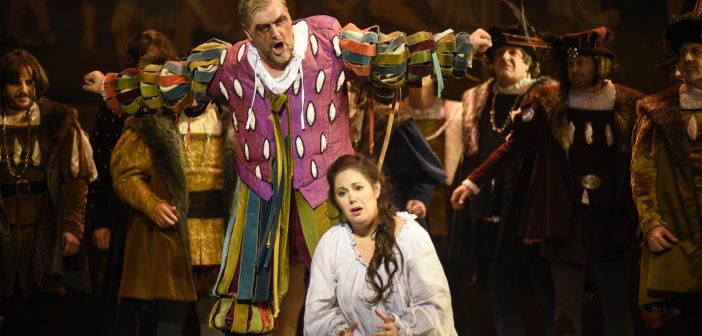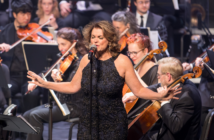Opéra de Montréal has launched its 39th season with Giuseppe Verdi’s Rigoletto.
The production counts on a mainly Canadian roster of singers lead by Ontario baritone James Westman in the title role and Quebec soprano Myriam Leblanc, a graduate of OdM’s Atelier lyrique, debuting as his daughter Gilda.
The lead cast initially was to be completed with Kosovian tenor Rame Lahaj in the role of the duke of Mantova, but was replaced by American upcoming opera star Rene Barbera.
The scenography is by Robert Dahlstrom, based on a 2010 co-production of Seattle Opera and San Diego Opera. It is a traditional style setting situated between 1500 and 1630, including an imposing statue replica of “the Rape of Proserpina” that is the centre piece during one of the scenes at Duke’s palace.
The production includes veteran Carlo Montanaro on the rostrum, L’Orchestre Metropolitain in the pit and Michael Cavanagh in stage direction.
Rigoletto’s plot is well known. Verdi and librettist Francesco Maria Piave adapted it from Victor Hugo’s play Le Roi s’amuse which was first performed in 1832.
The highlight of the night was Montanaro’s conducting and the Orchestre Metropolitain’s playing. The violin section sounded sumptuous. The orchestra also executed with cutting rhythmic precision, emphasizing the doted quaver note figures that are signature of Verdi’s musical style. Their best moment came during the overture.
Vocally, American tenor Rene Barbera stood out, displaying good mastery in negotiating the difficult high tessitura that the role of the Duke presents. His best moment came in the aria “Parmi Veder le Lagrime” where he revealed a full lyrical tenor sound.
Baritone James Westman’s portrayal of Rigoletto was adequate. The best characteristic of his singing was his diction and command of his high notes. However his acting lacked the emotional depth Rigoletto requires. On many occasions his gestures had no purpose and felt awkward.
The soprano Myriam Leblanc showcased a languid but somewhat charming voice. Her voix blanche timbre aided to convey the idea of Gilda being a pure, innocent and very young victim.
The Stage directing was nebulous. Cavanagh tried to play into the “commedia dell’arte” by inserting practical gags in the work. However Rigoletto is mainly a tragedy and inserting too many comedic elements can make the plot unconvincing. Also the placement of the soloist during many scenes wasn’t conductive to a better understanding of the drama. For example: in Rigoletto’s aria “Cortigiani vil razza dannata,” he had Marulo and the choir of courtesans placed upstage, leaving Rigoletto alone downstage to sing his plead for mercy to the audience when iIt would have more logical and effective if he was facing the courtesans.
Also, it was unclear why Rigoletto didn’t wear his emblematic hat throughout the piece, it was like seeing a superman movie where the superhero was not wearing his signature cape.
The next performances of Rigoletto at the Opera of Montréal will be held on September 18, 20 and 22. Their 2018-19 season will also feature Wagner`s Das Rheingold, the contemporary opera Champion by Blanchard and Cristofer, Twenty seven by Gordon & Vavrek and the ever popular Carmen by Bizet. www.operademontreal.com
















